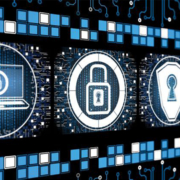The Best Cybersecurity Training for Employees
There’s a saying among cybersecurity professionals that humans are the weakest link. Luckily, this is only true if you treat them that way. If you train your people effectively, they become the vanguard in your cybersecurity defenses. To achieve this, you need the best security training for employees.
The Best Cybersecurity Training for Employees Includes Interactive Learning
| Types of Cybersecurity Training | ||
| Training Type | Pros | Cons |
| Keynote Speeches and Seminars | ➕Connects with employees so they take security personally ➕Highlights real-world examples ➕Follow-up questions can be asked ➕ Most current threats are discussed |
➖Can be expensive to hire a speaker and gather employees at the conference/offsite location |
| Simulated Phishing Exercises | ➕Raises awareness about phishing techniques ➕Encourages a cautious approach to online communication |
➖Exercises alone can’t prevent human error ➖Not engaging ➖ One step behind cyber criminals |
| Gamified Learning Platforms | ➕Engages employees through game-like elements ➕Can cover a range of cybersecurity topics |
➖Costly to update so games can become outdated quickly ➖Game is one-and-done with little follow-up |
| eLearning Modules and Online Courses | ➕ Employees can train at their convenience ➕Can be customized for a particular company or topic |
➖Requires employee self-discipline ➖Can be prone to technical issues ➖Little follow-up ➖Becomes outdated quickly |
| Security Awareness Programs | ➕Keeps employees informed of the latest cybersecurity threats ➕Conveniently done at the workplace |
➖Quality might not be the best ➖Can become a “check the box” exercise for employees |
| Role-Based Training | ➕Is tailored to specific employee roles ➕Improves on-the-job problem-solving skills |
➖ Time-consuming to set up ➖ Costly to operate |
| Red Team/Blue Team Exercises | ➕ Hands-on training in incident response ➕Fosters proactive security among employees |
➖Time and resource intensive ➖Tests a limited range of vulnerabilities and response options |
Keynote Speakers and Seminars
Hiring a cybersecurity keynote speaker allows employees to actively engage with the speaker and buy into what they’re learning. Depending on your organization’s requirements, these speeches and seminars can cover various topics, such as:
The interactive nature of these sessions encourages participation, facilitates knowledge retention, and allows for real-time clarification of questions. The speaker can share real-world examples and lessons learned and keep the content up to date with the latest threats.
At the same time, hiring a speaker takes a committed investment, and sending employees to conferences and offsite locations requires the expenditure of time and resources. However, when measured against the cost of a breach, which can reach into the millions, the expense of prevention is rather small by comparison.
Simulated Phishing Exercises
Phishing attacks remain one of the most common and successful methods employed by cybercriminals. Simulated phishing exercises involve sending mock emails to your employees to test their ability to identify and report suspicious messages.
These exercises help raise awareness about phishing techniques, educate employees on warning signs, and encourage a cautious approach when interacting with emails and other online communications.
Unfortunately, these exercises don’t necessarily engage employees, and the content is often a step or two behind the latest phishing techniques used by cybercriminals.
Gamified Learning Platforms
Considering we never truly outgrow the thrill of recess and Legos, gamification is an effective way to make cybersecurity engaging and memorable. What is fun is sustainable (yes, even cybersecurity!), and we can leverage this in the professional world by incorporating:
- Challenges
- Badges
- Progress bars
- Rewards
- Leaderboards
Gamified learning platforms can cover various topics, from basic security awareness to more advanced concepts like network security, secure coding, and incident response.
On the other hand, these platforms can be costly to develop and update, so they can become outdated quickly. And, once the game is over, the training is over as well.
eLearning Modules and Online Courses
eLearning modules and online courses provide employees with flexible and self-paced learning opportunities. These modules can be designed to address specific cybersecurity topics, allowing employees to access training materials at their convenience.
Online courses can also offer certifications or badges upon completion, further incentivizing employees to participate and enhance their cybersecurity knowledge and skills actively.
On the negative side, eLearning requires self-discipline from your employees, it can be disrupted by technical issues, and there is little follow-up. Because–let’s face it–assignments without accountability measures are bound to end up at the bottom of the to-do list. Employees tend to view eLearning as something they have to do to fulfill organizational requirements, not as a way to learn valuable cybersecurity skills.
Security Awareness Programs
Cybersecurity threats and trends evolve rapidly, making continuous training and security awareness programs essential. It is through learning that we stay one step ahead. Regularly scheduled training sessions, newsletters, and awareness campaigns can keep employees informed about the latest threats, emerging attack techniques, and security best practices in the comfort of their office.
But the quality and effectiveness of security awareness programs developed by organizations can vary. Managers and employees often see security awareness training as a “check the box” exercise rather than a meaningful learning experience.
Role-Based Training
Different organizational job roles may have varying cybersecurity requirements. Tailoring training programs to specific roles and responsibilities ensures that employees receive targeted and relevant instruction.
For example, IT staff might require more technical training, while non-technical employees may benefit from cybersecurity basics and secure remote work practices.
Unfortunately, role-based training can be time-consuming to develop and implement and costly to conduct. In addition, the training can become outdated quickly as cyber threats evolve and employees change jobs.
Red Team/Blue Team Exercises
Red team/blue team exercises divide employees into two groups: the “red team” simulates attackers, while the “blue team” defends against their attacks. This is the adult world’s version of gym class dodgeball. It is through such exercises that we learn how to make defensive moves into offensive and proactive play.
These exercises provide hands-on experience in:
- Identifying vulnerabilities
- Improving incident response capabilities
- Fostering a proactive security mindset
Red team/blue team exercises can be time-consuming and resource intensive. They often test only a limited range of vulnerabilities and response options in their attack scenarios.
Regular assessments, feedback mechanisms, and opportunities for employees to apply their learning in real-world scenarios are crucial for long-term cybersecurity readiness. Finding the best training method for your employees can transform them from your weakest link to your first line of defense against cyber threats.
To help you on your journey, John Sileo leverages potent lessons learned from losing his business to cybercrime as well as a humorous live-hacking demonstration to connect with your employees and drive home cybersecurity training that will stick. He is eager to provide the best cybersecurity training for employees tailored to your organization’s requirements.
___________________________
John Sileo is an award-winning cybersecurity keynote speaker who has entertained and informed audiences for two decades. He is proud to have spoken at the Pentagon and Amazon, written four books on cybersecurity, and been inducted into the National Speakers Hall of Fame. He has appeared on 60 Minutes, NBC, ABC, Fox, CNN, Rachael Ray, and Anderson Cooper. John’s work has been quoted and published in The Wall Street Journal, The Washington Post, USA Today, and Kiplinger’s.
Looking for a customized speech to make your next event unforgettable? Call 303.777.3221 or fill out our contact form to connect with Sue, our business manager extraordinaire. She’ll work with you to brainstorm ideas and explore how John can tailor his speech to fit your needs perfectly.






 sileo.com
sileo.com 




